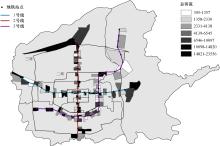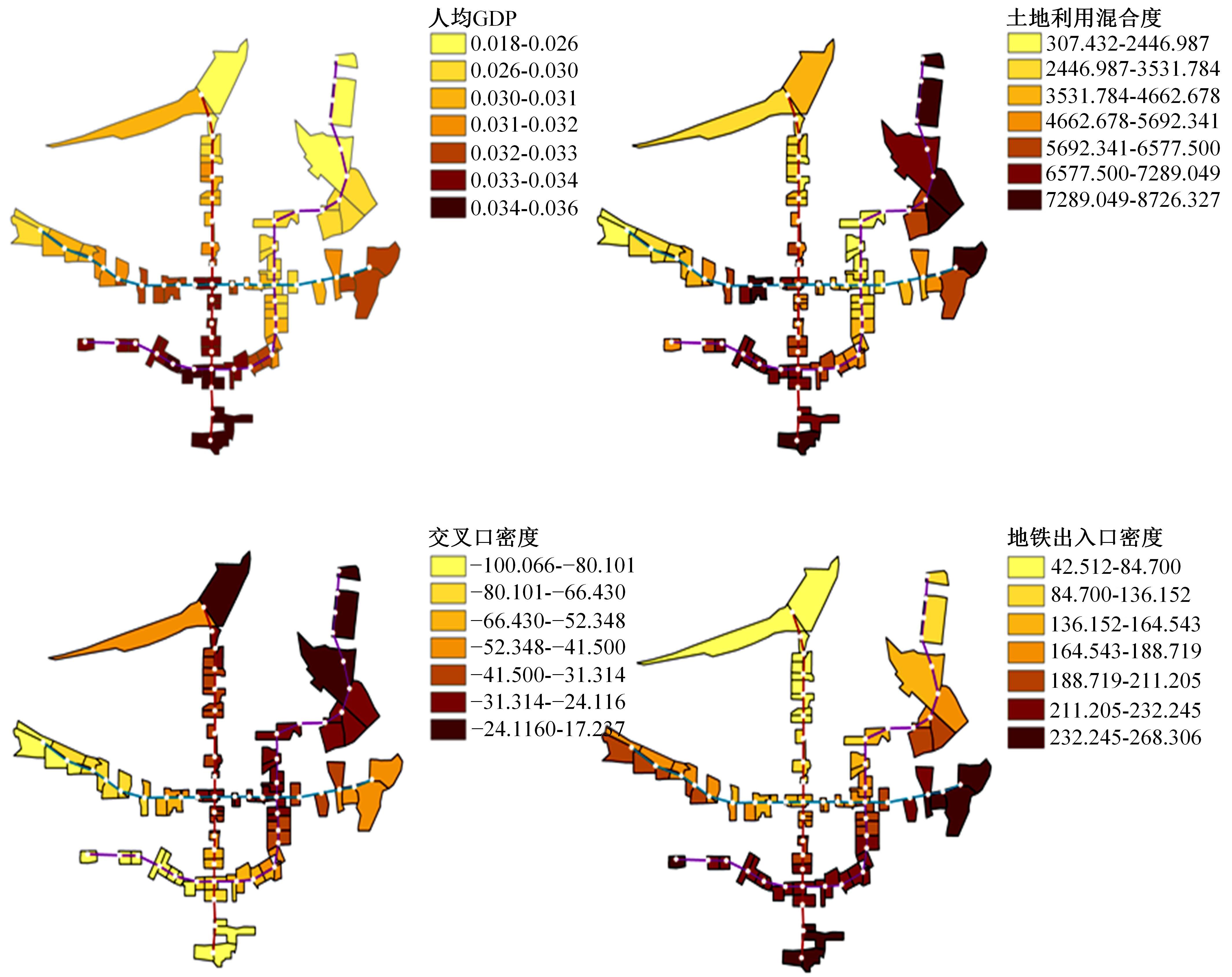Journal of Jilin University(Engineering and Technology Edition) ›› 2024, Vol. 54 ›› Issue (7): 1913-1922.doi: 10.13229/j.cnki.jdxbgxb.20221236
Heterogeneity of built environment on commuter passenger flow of subway in traffic analysis zones
Shu-hong MA( ),Guo-mei LIAO,Yan HUANG,Jun-jie ZHANG
),Guo-mei LIAO,Yan HUANG,Jun-jie ZHANG
- College of Transportation Engineering,Chang′an University,Xi′an 710064,China
CLC Number:
- U491
| 1 | 中国城市规划设计研究院.2020年度全国主要城市通勤监测报告[R/OL]. [2021-04-18]. . |
| 2 | 中国城市规划设计研究院. 2021年度全国主要城市通勤监测报告[R/OL]. [2022-04-20]. . |
| 3 | Wang J, Zhang N P, Peng H, et al. Spatiotemporal heterogeneity analysis of influence factor on urban rail transit station ridership[J]. Journal of Transportation Engineering, Part A: Systems, 2022, 148(2): No. 04021115. |
| 4 | Loo B P Y, Chen C, Chan E T H. Rail-based transit-oriented development: lessons from New York City and Hong Kong[J]. Landscape and Urban Planning, 2010, 97(3): 202-212. |
| 5 | 王玉萍, 陈宽民, 杨富社, 等. 城市轨道交通客流预测结果的技术分析体系[J]. 长安大学学报: 自然科学版, 2011, 31(3): 72-80. |
| Wang Yu-ping, Chen Kuan-min, Yang Fu-she, et al. Analysis system of urban rail transit passenger flow forcast result[J].Journal of Chang'an University (Natural Science Edition), 2011, 31(3):72-80. | |
| 6 | Kuby M, Barranda A, Upchurch C. Factors influencing light-rail station boardings in the United States[J]. Transportation Research Part A: Policy and Practice, 2004, 38(3): 223-247. |
| 7 | 江世雄, 蔡灿煌, 林宇晨, 等. 天气因素对福州地铁客流的影响分析[J]. 交通运输系统工程与信息, 2021, 21(3): 268-274. |
| Jiang Shi-xiong, Cai Can-huang, Lin Yu-chen, et al. Analysis of weather´s influences on metro ridership in Fuzhou[J].Journal of Transportation Systems Engineering and Information Technology, 2021, 21(3): 268-274. | |
| 8 | Xin M W, Shalaby A, Feng S M, et al. Impacts of COVID-19 on urban rail transit ridership using the synthetic control method[J]. Transport Policy, 2021, 111: 1-16. |
| 9 | Cummings C, Mahmassani H. Does intercity rail station placement matter? Expansion of the node-place model to identify station location impacts on Amtrak ridership[J]. Journal of Transport Geography, 2022, 99: No.103278. |
| 10 | Najafabadi S, Hamidi A, Allahviranloo M, et al. Does demand for subway ridership in Manhattan depend on the rainfall events?[J]. Transport Policy, 2019, 74: 201-213. |
| 11 | Liu Y, Liu Z, Jia R. DeepPF: a deep learning based architecture for metro passenger flow prediction[J]. Transportation Research Part C: Emerging Technologies, 2019, 101: 18-34. |
| 12 | Li S Y Liu D J, Huang G P, et al. Spatially varying impacts of built environment factors on rail transit ridership at station level: a case study in Guangzhou, China[J]. Journal of Transport Geography, 2020, 82: No.102631. |
| 13 | Lanza K, Oluyomi A, Durand C, et al. Transit environments for physical activity: relationship between micro-scale built environment features surrounding light rail stations and ridership in Houston, Texas[J]. Journal of Transport & Health, 2020,19: No. 100924. |
| 14 | 高德辉, 许奇, 陈培文, 等. 城市轨道交通客流与精细尺度建成环境的空间特征分析[J]. 交通运输系统工程与信息, 2021, 21(6): 25-32. |
| Gao De-hui, Xu Qi, Chen Pei-wen, et al. Spatial characteristics of urban rail transit passenger flows and fine-scale built environment[J]. Journal of Transportation Systems Engineering and Information Technology, 2021, 21(6): 25-32. | |
| 15 | 申犁帆, 王烨, 张纯, 等. 轨道站点合理步行可达范围建成环境与轨道通勤的关系研究——以北京市44个轨道站点为例[J]. 地理学报, 2018, 73(12):2423-2439. |
| Shen Li-fan, Wang Ye, Zhang Chun, et al. Relationship between built environment of rational pedestrian catchment areas and URT commuting ridership: evidence from 44 URT stations of Bejing[J]. Acta Geographica Sinica, 2018, 73(12): 2423-2439. | |
| 16 | .土地利用现状分类 [S]. |
| 17 | Yan X, Zhou J, Sheng F, et al. Influences of built environment at residential and work location-s on commuting distance: evidence from Wuhan, China[J]. ISPRS International Journal of Geo-Information, 2022, 11(2): 124. |
| 18 | Yang H, Lu X, Cherry C, et al. Spatial variations in active mode trip volume at intersections: a local analysis utilizing geographically weighted regression[J]. Transp Geogr,2017, 64: 184-194. |
| 19 | Brunsdon C, Fotheringham A S, Charlton M E. Geographically weighted regression: a method for exploring spatial nonstationarity[J]. Geographical Analysis, 1996, 28(4): 281-298. |
| 20 | Akaike H. A new look at the statistical mode-l identification[J]. IEEE Transactions on Automatic Control, 1974, 19(6): 716-723. |
| 21 | Brunsdon C, Fotheringham A S, Charlton M. Geographically weighted summary statistics-a framework for localised exploratory data analysis[J]. Computers, Environment and Urban Systems, 2002, 26(6):501-524. |
| [1] | Zhi-hua XIONG,Dai-yue DONG,Chun-jiao DONG,Yan ZHENG,Chao XIE. Combined decision-choice behavior of spectators considering personal preferences [J]. Journal of Jilin University(Engineering and Technology Edition), 2024, 54(4): 979-986. |
| [2] | Jiao-rong WU,Qing-kai LIN,Yong-qi DENG. Identification method of potential public transportation lane demand based on bus line operation stability [J]. Journal of Jilin University(Engineering and Technology Edition), 2024, 54(3): 692-699. |
| [3] | Wen-hui ZHANG,Jing YI. Optimization of bus stop system considering capacity and queuing delays [J]. Journal of Jilin University(Engineering and Technology Edition), 2024, 54(1): 146-154. |
| [4] | Chao-ying YIN,Ying LU,Chun-fu SHAO,Jian-xiao MA,De-jie XU. Impacts of built environment on commuting mode choice considering spatial autocorrelation [J]. Journal of Jilin University(Engineering and Technology Edition), 2023, 53(7): 1994-2000. |
| [5] | Xian-yan KUANG,Zi-ru CHEN. Dynamic game comity behavior at pedestrians′ crossing on unsignal-controlled roads based on cellular automata [J]. Journal of Jilin University(Engineering and Technology Edition), 2022, 52(4): 837-846. |
| [6] | Hong-fei JIA,Zi-han SHAO,Li-li YANG. Ride⁃sharing matching model and algorithm of online car⁃hailing under condition of uncertain destination [J]. Journal of Jilin University(Engineering and Technology Edition), 2022, 52(3): 564-571. |
| [7] | Chao-ying YIN,Chun-fu SHAO,Zhao-guo HUANG,Xiao-quan WANG,Sheng-you WANG. Investigating influences of multi⁃scale built environment on car ownership behavior based on gradient boosting decision trees [J]. Journal of Jilin University(Engineering and Technology Edition), 2022, 52(3): 572-577. |
| [8] | Chun-jiao DONG,Dai-yue DONG,Cheng-xiang ZHU-GE,Li ZHEN. Trip characteristics and decision⁃making behaviors modeling of electric bicycles riding [J]. Journal of Jilin University(Engineering and Technology Edition), 2022, 52(11): 2618-2625. |
| [9] | Jing-xian WU,Hua-peng SHEN,Yin HAN,Min YANG. Residents' commuting time model under the nonlinear impact of urban built environment [J]. Journal of Jilin University(Engineering and Technology Edition), 2022, 52(11): 2568-2573. |
| [10] | Shi-jun YANG,Yu-long PEI,Heng-yan PAN,Guo-zhu CHENG,Wen-hui ZHANG. Characteristics analysising and prediction of dwelling time of urban bus [J]. Journal of Jilin University(Engineering and Technology Edition), 2021, 51(6): 2031-2039. |
| [11] | Chao-ying YIN,Chun-fu SHAO,Xiao-quan WANG,Zhi-hua XIONG. Influence of built environment on commuting mode choice considering spatial heterogeneity [J]. Journal of Jilin University(Engineering and Technology Edition), 2020, 50(2): 543-548. |
| [12] | Chao⁃ying YIN,Chun⁃fu SHAO,Xiao⁃quan WANG. Influence of urban built environment on car commuting considering parking availability [J]. Journal of Jilin University(Engineering and Technology Edition), 2019, 49(3): 714-719. |
| [13] | Lei CHEN,Jiang⁃feng WANG,Yuan⁃li GU,Xue⁃dong YAN. Multi⁃source traffic data fusion algorithm based onmind evolutionary algorithm optimization [J]. Journal of Jilin University(Engineering and Technology Edition), 2019, 49(3): 705-713. |
| [14] | YU De-xin,YANG Zhao-sheng,GAO Peng. Constrained K-shortest paths algorithm within |dynamic restricted searching area [J]. 吉林大学学报(工学版), 2009, 39(增刊2): 172-0176. |
| [15] | YANG Zhao-sheng, YU Yue, YANG Wei. Acquisition of travel time based on inductive coil detector and probe vehicle [J]. 吉林大学学报(工学版), 2009, 39(增刊2): 168-0171. |
|
||





